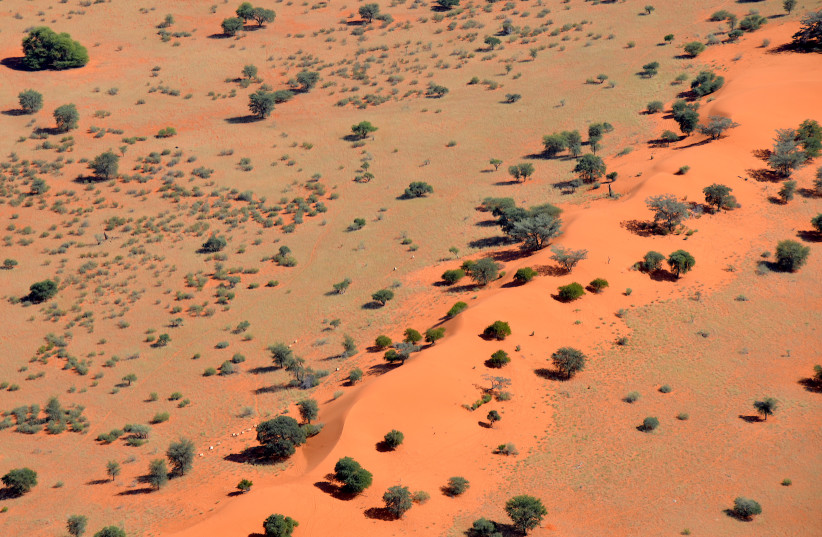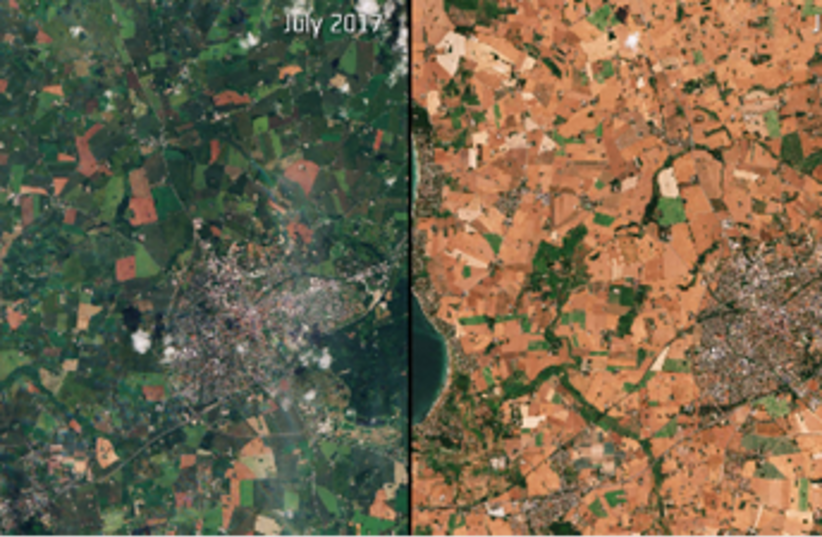Hebrew University scientists suggest that climate change is causing these dryland mechanisms to increasingly affect Earth’s wetter areas.
Published: AUGUST 16, 2022

(photo credit: OLGA ERNST & HP. BAUMELER/CC BY-SA 4.0 (https://creativecommons.org/licenses/by-sa/4.0)/WIKIMEDIA)
Severe forest fires on the US West Coast, deadly rainstorms and floods, record-breaking heat spells in Europe, early snowmelts at the poles and other extreme weather have become regular – and shocking – news items in recent years.
When it comes to the world’s climate in the past decade, planet Earth keeps sending us worrisome reminders of the effects of man’s pollution and global warming.
According to NASA, 10 of the hottest years have occurred since 2000, with 2016 and 2020 tied for the hottest on record. Even cool England had summer temperatures above 40 degrees Celsius (104°F).
If heat waves and severe droughts continue to hold across the globe, what will the future bring to temperate and tropical forests and croplands?
Scientists are looking at the unique adaptations of desert life, which functions by its own set of rules long considered unique to dry areas.
Now, new research by an international team of scientists led by Hebrew University of Jerusalem Prof. José Grünzweig and co-authored by his university colleagues Prof. Efrat Sheffer and Prof. Ori Adam and Dr. David Helman, suggests that climate change is causing these dryland mechanisms to increasingly affect Earth’s wetter areas.
Their findings were published in Nature Ecology and Evolution under the title “Dryland mechanisms could widely control ecosystem functioning in a drier and warmer world.”
“To better predict how the world’s wetter regions will operate in a hotter and drier climate, we should begin to apply what my colleagues and I have learned from how nature functions in dry regions,” Grünzweig said.
Impact of extreme heatwave and drought in summer 2018 compared to summer 2017, on fields near Slagelse in Zealand, Denmark. (credit: European Space Agency)
Prompted by a recent meeting of the European Ecological Federation and an action of the European Cooperation in Science and Technology, the research team compiled a list of unique rules of life driving dryland ecosystems.
More than a third of the Earth’s land area is now drylands. Many of these key processes – including rapid cycling between wet and dry conditions that influence plant and animal activity, redistribution of water in soils by plant roots, and formation of living crusts on soil surfaces by microscopic organisms – had previously been considered relevant only to arid regions.
What did the team identify?
The team identified a dozen different dryland mechanisms affecting vegetation distribution, plant growth, water flow, energy budget, carbon and nutrient cycling and decomposition of dead material. These mechanisms were categorized as either more likely to be fast-responding – those that we might expect to see occurring from short-term drought, such as dry-wet cycles, heat and sunlight breaking down dead material; or slow-responding – those that would happen after years of dry conditions, such as formation of living crust on soils, as a result of changes in plant distribution.
THE RESEARCHERS presented 12 dryland mechanisms that are routine in drylands but not commonly found or studied in wet systems. They then categorized these mechanisms based on how likely it is that they would occur among wetter systems in the future.
“I have been studying drylands and their unique behaviors throughout my academic life that until now were considered unique to regions such as ours in Israel,” Grünzweig said. “Today, I think it is crucial to bring these ideas to the attention of researchers and the public elsewhere, calling people to look for the unprecedented emergence of these dryland mechanisms in response to climate change in their backyard.”
For example, much of Europe experienced a severe drought and heat wave in the summer of 2018. As a result, the low plant cover in agricultural fields during this time likely led to desert-like biological processes occurring in these historically wet locations. A new heat wave has now hit Europe. Under these conditions, plant growth decreases dramatically, leading to more soil exposure on surfaces that are not covered by plants.
Dry soil conditions will spur many dryland mechanisms, such as redistribution of soil water through plant roots. Other mechanisms will respond to changes in vegetation, with more sparsely distributed vegetation increasing the number of organisms forming soil surface crusts and increasing the role of sunlight in breaking down dead leaves.
“We’ve been studying for years how in our dry environments plants are organized in a patchy structure compared to the dense cover of vegetation typical of wet areas, but now we understand that plants anywhere will reorganize to meet new climate conditions,” Sheffer said.
To better understand the potential effects of dryland mechanisms on vegetation distribution and decomposition of dead material, the research team used its drylands’ data to model how the forces driving drylands will increasingly be applied to temperate regions under future climate conditions. The results were stunning.
“Our data predict that by the end of the 21st century, the total non-dryland area with average topsoil temperature of more than 40 degrees Celsius is estimated to increase by about 17 million square kilometers – equal roughly to the combined land area of the US and Brazil,” Adam said.,
Helman said: “In this study, we present the first estimation of global soil water potential – a measure of drought relevant to most dryland mechanisms. Our projections for the end of this century imply that soil drought will increase markedly in the humid regions of South America, Africa and Oceania, with considerable regional drying also in North America and Europe.”
Some of these projected changes will occur in regions with large human populations and significantly affect the well-being of society in these regions. The new insights of this study can contribute to advancing society’s capacity to withstand climate extremes and lessen their impacts on nature and people, the authors suggested.
“A better understanding of our desert systems could lead society to set more realistic expectations for climate change’s effects on historically wetter areas and a more successful attempt to heed Mother Nature’s warnings,” they wrote.
https://www.jpost.com/environment-and-climate-change/article-714848

